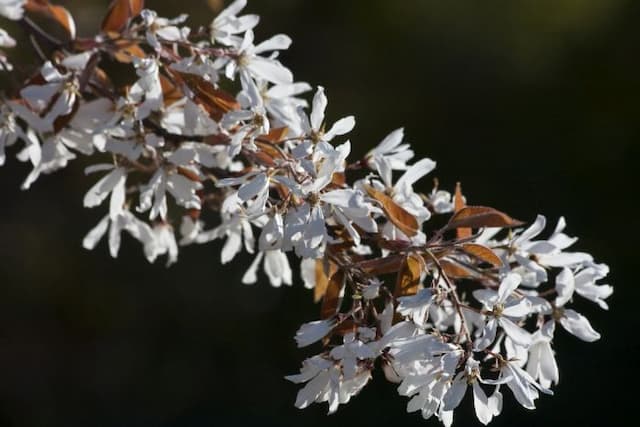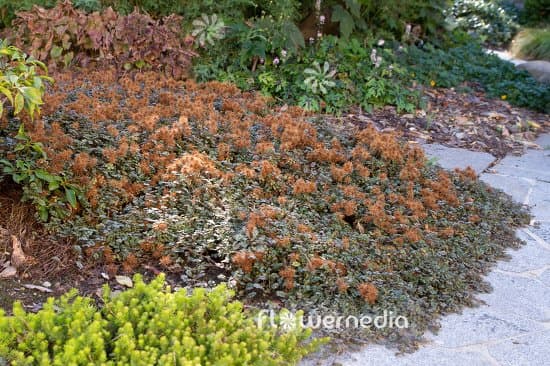Blackthorn Prunus spinosa



ABOUT
Prunus spinosa, also known as Blackthorn or Sloe, is a species of flowering plant that is native to Europe, Asia, and North Africa. It is a deciduous shrub or small tree that can grow up to 20 feet tall.
The wood of the plant is hard and heavy, dark brown with a fine, straight grain and a smooth texture. It is strong and durable, and is often used for making tools, implements, and fencing. The bark is dark brown, rough and scaly.
Blackthorn has very sharp, dark-colored thorns that are up to 1 inch long, and are often found along the branches and twigs.
The leaves are simple, alternate and have a dark green color, they are oval or oblong-shaped, and have a serrated margin. They are typically 1-3 inches long and 1 inch wide.
The flowers of Blackthorn are small, white, and appear in clusters before the leaves in spring. They have five petals and are about 1/2 inch wide.
The fruit is a drupe, about 1/4 inch in diameter, that is dark blue to black in color when ripe. They are edible but quite sour, often used for making jams and syrups.
About this plant
 Names
NamesFamily
Rosaceae
Synonyms
Sloe, Buckthorn, Bullace, Skeg, Sloe plum, Snag
Common names
Prunus platyphylla, Prunus myriocephala, Prunus stilboacantha
 Toxicity
ToxicityTo humans
Blackthorn s considered to be toxic to humans if consumed in large amounts.
The leaves and bark contain cyanogenic glycosides, which can release cyanide in the body if ingested.
The fruit is also known to cause stomach upset if consumed in large quantities. Symptoms of cyanide poisoning include headaches, dizziness, nausea, vomiting, rapid breathing, and in severe cases, seizures, coma and death.To pets
Prunus spinosa is considered to be toxic to certain types of animals, especially livestock.
The leaves, bark, and twigs contain cyanogenic glycosides, which can release cyanide in the body if ingested. This can lead to symptoms such as gasping, muscle tremors, and in severe cases, death.
The fruit is also known to cause stomach upset if consumed in large quantities.
It's important to note that different animals may have different susceptibility to the toxicity of the plant, and it's always best to consult with experts if necessary.
 Characteristics
CharacteristicsLife cycle
Perennials
Foliage type
Deciduous
Color of leaves
Green and yellow in the fall
Flower color
White
Height
Up to 20 feet
Spread
Up to 20 feet
Plant type
Tree
Hardiness zones
3
Native area
Europe, Asia, and North Africa
Benefits
 General Benefits
General BenefitsBlackthorn is an important food source for many species of birds and mammals, providing food in the form of the fruit, shelter and nesting sites in the form of dense thickets, and protection in the form of thorns;
The dense network of roots and the deep-reaching taproots of blackthorn make it an excellent soil stabilizer, preventing erosion on steep slopes and along riverbanks;
Blackthorn is a popular ornamental shrub or small tree that is often planted in gardens, parks and other landscaped areas, due to its attractive flowers, fruit, and thorny branches;
The fruit of the Blackthorn, called sloes, are edible, although quite sour, often used for making jams and syrups. Medical Properties
Medical PropertiesBlackthorn has been traditionally used to treat stomach complaints such as indigestion, constipation and diarrhea;
The leaves and bark of Blackthorn have been traditionally used to treat respiratory infections such as bronchitis and asthma;
Blackthorn has been traditionally used to treat skin conditions such as eczema, psoriasis, and wounds;
Blackthorn has been traditionally used to alleviate rheumatism and joint pain, due to its anti-inflammatory properties;
Blackthorn has been traditionally used to improve cardiovascular health and lower blood pressure, due to its flavonoid content.
It's important to note that these medical uses have not been scientifically proven and the plant should not be used as a replacement for conventional medical treatment. It's always best to consult with a healthcare professional before attempting to use the plant for medicinal purposes, and to be aware of potential interactions with other medications. Air-purifying Qualities
Air-purifying QualitiesBlackthorn has been found to have some air purifying qualities.
The plant is known to produce high concentrations of volatile organic compounds (VOCs), which are compounds that can help reduce the presence of certain pollutants in the air.
Blackthorn has been found to reduce the levels of nitrogen oxides, formaldehyde, and benzene in the air.
It has also been found to reduce the levels of particulate matter, which can be detrimental to our health. Additionally, the plant is known to release compounds such as terpenes, which can help reduce the levels of harmful bacteria and fungi in the air. Other Uses
Other UsesBlackthorn is a traditional hedging plant in the UK and Europe. The thorns are used to make hedges impenetrable, and the branches are woven together to create a living fence;
The hard wood of blackthorn is often used to make walking sticks, due to its strength and durability;
The wood of blackthorn is also used to make whistles because of its ability to produce a clear, high-pitched sound;
Blackthorn is also used to make wands in some cultures, due to its strong association with magic and protection;
The small, dark blue to black fruit of the blackthorn, called sloes, are sometimes used to make jewelry, such as earrings, necklaces, and bracelets.
Interesting Facts
 Feng Shui
Feng ShuiIn feng shui, blackthorn is not traditionally used as it is considered to be a thorny and spiky plant, and it's not considered to have a positive energy for the home.
However, if you wish to use it in your garden, it's best to place it in an area of your property where it can be appreciated from a distance and not directly in front of the main entrance of your house. Plant Symbolism
Plant SymbolismIn folk traditions, Blackthorn has been associated with protection, magic, and the afterlife. It was believed to ward off evil spirits and protect against negative energy.
In mythology, it was often associated with the goddess of death and the underworld.
In literature and poetry, it is often used as a symbol of harshness, danger, or sorrow.
 Water
WaterBlackthorn is a drought-tolerant plant that does not require frequent watering. It is best to water the plant deeply, but infrequently, allowing the soil to dry out slightly between watering.
In general, it is recommended to water once a week, or less often during the winter months. It is important to avoid overwatering, as this can lead to root rot. Light
LightPrunus spinosa is a plant that prefers full sun to partial shade.
It will tolerate a wide range of light conditions, but it will produce more fruit and have a denser growth habit if it receives full sun. Temperature
TemperaturePrunus spinosa is a hardy plant that can tolerate a wide range of temperatures. It is hardy in USDA zones 4 and higher.
It can survive temperatures as low as -30°F and as high as 100°F. Pruning
PruningPrunus spinosa can be pruned to shape the plant and remove dead or diseased leaves and wood. It's best to prune in late winter or early spring before new growth appears. Prune out any dead, diseased or damaged wood. If you want to control the size of the plant, prune back the longer branches to a side shoot. If you want to increase fruit production, remove the oldest branches.
 Soil
SoilBlackthorn is a plant that is adaptable to a wide range of soils, but prefers well-drained soil.
The best soil for Prunus spinosa is a moist, well-drained soil with a slightly acidic to neutral pH (6.0-7.0). It can tolerate some dryness and can grow on sandy, loamy, or clay soils. Repotting
RepottingPrunus spinosa is a slow-growing plant and does not require frequent repotting. It can be grown in the same pot for several years.
If you notice that the plant is outgrowing its container, or if the roots are becoming crowded, you can repot it in the spring. Humidity & Misting
Humidity & MistingPrunus spinosa is a tough and hardy plant that can tolerate a wide range of humidity levels. It can tolerate both dry and humid conditions. It is not necessary to provide additional humidity for this plant.
 Suitable locations
Suitable locationsIndoor
Blackthorn is not typically grown indoors as it is a thorny shrub that can grow up to 20 feet tall and is not suitable for small indoor spaces.
However, if you want to try growing it indoors, it will require a lot of light and a cool room with temperatures between 50-65°F.
Provide a well-draining soil and be sure to keep it on the dry side as it does not like to be overwatered.Outdoor
Prunus spinosa is a hardy plant that can be grown outdoors in a wide range of soil and climate conditions.
It prefers full sun to partial shade and prefers well-drained soil. It is drought-tolerant and can survive in temperatures as low as -30°F and as high as 100°F.
It is a slow-growing plant, but can grow up to 20 feet tall.Hardiness zone
USDA 4 - 11
 Life cycle
Life cyclePrunus spinosa is a deciduous shrub or small tree that belongs to the Rosaceae family. The plant has a lifespan of about 30-50 years.
The life cycle of Prunus spinosa begins in the spring, when the plant starts to grow new leaves and produces small, white flowers. These flowers are followed by small, dark blue to black fruit called sloes. The fruit matures in the fall, and is usually ready to harvest in late September or October.
During the growing season, the plant will continue to grow leaves and produce flowers, but it will also be storing energy in its roots and branches in preparation for the dormant period during the winter.
In the fall, the leaves of Prunus spinosa will turn yellow or red before falling off. The plant will enter a dormant period during the winter months, during which time it will not grow or produce flowers.
The cycle begins again in the spring, when the plant wakes up from dormancy and starts to grow new leaves and produce flowers once again. Propogation
PropogationPropogation time
Spring - early summer
By SEEDS:
The seeds of Prunus spinosa can be collected from the ripe fruit in the fall and sown in a seed tray or pots filled with seed compost. Keep the seed tray or pots in a cold frame or greenhouse, and germination will occur the following spring.
By SOFTWOOD CUTTINGS:
Softwood cuttings can be taken in late spring or early summer. Cuttings should be taken from the current season's growth, and be 6-8 inches long with a heel. Dip the base of the cutting in rooting hormone powder and insert into a pot filled with a mixture of sand and peat moss. Cover with a plastic bag and place in a propagator or a plastic bag and keep in a warm place.
By HARDWOOD CUTTINGS:
Hardwood cuttings can be taken in the late fall or winter. Cuttings should be taken from the previous year's growth, be 4-6 inches long, and inserted into a pot filled with well-draining soil. Cover with a plastic bag and place in a cool, shady spot.
By LAYERING:
Layering can be done in the spring by bending a branch to the ground, making a small incision in the bark and covering the area with soil. Roots will form where the incision was made. Once roots have formed, the branch can be severed from the parent plant and planted.
 Pests
PestsAphid, Japanese beetle, Coddling moth, Caterpillar
 Diseases
DiseasesRoot Rot, Powdery mildew, Leaf spot, Fire blight, Canker









